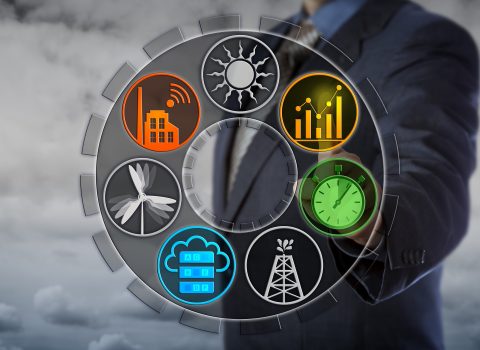
Support tools for the hydrogen industry. Priorities for the development of the hydrogen supply chain in Italy
The Report by H2IT - Italian Association of Hydrogen and Fuel Cells has been presented: hydrogen is a key solution for the decarbonization of the energy system
2020 has been the turning point for European environmental policies. Partly due to the health emergency and public attention to green issues, the EU has launched a strategy that plans to reduce CO2 emissions by 100% by 2050. In this context, hydrogen represents a key solution, complementary with other technologies, for the decarbonization of the energy system.
Hydrogen is an energy vector that does not generate CO2 emissions; moreover, when produced from renewable sources through the process of water electrolysis, it is both carbon- and polluting emissions-free .
It can be stored for a long time either as gas or a liquid and existing transportation and distribution infrastructures can be used with sustainable adjustment costs. It can be used in different types of vehicles for the mobility of goods and people, as a raw material in factories, as a fuel in high-temperature processes; it can be used for factories and homes as a instead of fossil fuels for the production of energy and heat, pure or mixed with natural gas, either through electrochemical processes with fuel cells or by burning it as a traditional fuel obtaining a combustion with zero CO2 emissions. Since storage that does not present particular safety issues, it therefore offers a solution to decarbonize industrial processes and energy sectors where reducing carbon emissions is urgent and hard to achieve.
But how can the smallest and most abundant element in the observable universe really be the keystone towards a sustainable energy model?
H2IT – the Italian Association for Hydrogen and Fuel Cells, presented the report “Support tools for the hydrogen sector. Priorities for the development of the hydrogen supply chain in Italy” in Milan on January 19, 2021 on the occasion of the digital event “Hydrogen: the future of energy is today”.
The meeting, moderated by Marcello Baricco from the University of Turin, was attended by Alberto Dossi, President of H2IT, Luigi Crema (FBK), Vice President of H2IT, Prof. Filomena Maggino, Prime Minister’s advisor and President of the Benessere Italia Commission, and politicians Vanessa Cattoi (Lega) and Andrea Vallascas (M5S).
Institutions and key players in the supply chain talked about the potential of this industry, and outlined the priorities for a National Hydrogen Strategy. What stands out, above all, the need for a solid and simplified regulatory framework and a long-term investment plan to develop infrastructures and fund research and innovation.
“Italy has the potential to strategically position itself in all areas in the hydrogen supply chain: production, logistics and transportation, industry, mobility, residential. – stated Alberto Dossi, President of H2IT – We have large operators and companies that are decisive in opening the market, SMEs and innovative start-ups, research centers of international standing. With this report, which involved 67 organizations active in the sector in its drafting, we wanted to make our contribution to the development of a market that will become increasingly central in the national and European economy. To overcome the challenge of decarbonization, the time has come to develop a National Hydrogen Strategy that will implement a broad plan of investments and reforms. H2IT, as the only voice in the Italian landscape, is ready to work alongside the institutions by providing all needed skills to facilitate decision-making.”
Luigi Crema (FBK), Vice President of H2IT, presented the Report with the contributions from 48 production sector players, 12 research centers and 7 clusters/associations. It contains the essential recommendations to create the political and regulatory conditions to support this sector in Italy.
A detailed study, which involved the entire supply chain and led to the identification of 51 action priorities and 66 policies, divided into 7 different segments: production; transportation, distribution and handling; storage; mobility; energy uses; industrial, residential and feedstock uses; supply chain and cross-segment issues.
Starting from these, H2IT suggests to the institutions some strategic priorities to break down the barriers to the development of the hydrogen sector in Italy:
- Defining the long-term strategic role of hydrogen: it is essential to trace a clear direction that will point to specific actions and specific goals to support this industry and enable investments. In its early development steps, public support will be needed to cover existing financial gaps through dedicated and stable long-term support.
- Developing a clear technical-regulatory framework: clear rules, simplified bureaucracy and standardization would allow the companies involved in the entire supply chain to operate, on a European scenario, in favorable conditions also for investments.
- Guaranteeing the certification of renewable and low-emission hydrogen: a certification system based on Guarantees of Origin in order to promote renewable and low-emission hydrogen, in line with European directives.
- Supporting research, innovation and training: in this development phase, the role of research centers is primary, and they must therefore be supported with simplified-accessibility funding for specific demonstration or research projects. The evolution of the industry will also require professionals specialized in many technical knowledge areas that can be created by investing in education, from high school to university to train future specialized technicians. A can’t-miss opportunity for a country that wants to restart by creating new employment opportunities.
- Developing a refueling infrastructure for mobility: the construction of a network of refueling stations for hydrogen powered vehicles is the best solution to allow the circulation of fuel cell powered vehicles for both light and heavy road transportation, but also dedicated to rail transport and vehicles in logistics hubs, such as ports and airports.
- Encouraging strategic collaboration between Hydrogen Valleys projects: it is a priority to identify the initial nuclei for the synergistic development of multiple end uses and to develop different applications in order to favor the growth of demand, the scale-up of technologies and, consequently, reduce costs.
- Raising awareness and informing public opinion: the development of the supply chain must be accompanied by information campaigns and educational projects on hydrogen technologies and on the safety procedures applied.

